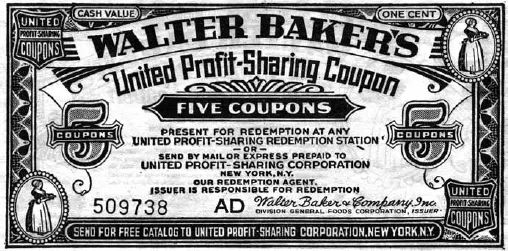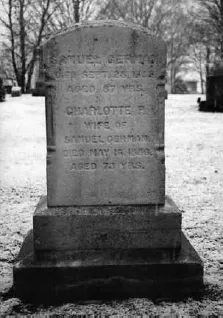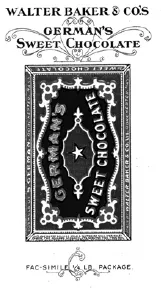![]()
EMPLOYEES AND ASSOCIATES
Everyone seemed to think Bakers was a good company to work for.
—Karen Mac Nutt
Not only was the Baker Chocolate Company in the Lower Mills/Milton Village the oldest manufacturer of chocolate in the United States, founded in 1765 and established in 1780, but it was also one of the first large companies in this country to establish and annually contribute to a profit-sharing plan for the benefit of its employees.
Profit-sharing plans, as well as 401(k) plans, are one of the many enticements used to retain key employees who make substantial contributions to the operation of a company. A plan that gives employees a share of the profits of the company is a great way to instill a sense of ownership and thereby extract high expectations and hopefully lengthy service from them. However, in 1904 the Forbes Syndicate, which had purchased the profitable chocolate company in 1897 for $4.75 million from the estate of Henry L. Pierce, gave a week’s salary to four hundred employees of the chocolate mills with one year or more of service as extra compensation.
In 1905, the Baker Chocolate Company was quoted by the Boston Transcript, a leading newspaper of the day, in a letter to employees:
The directors of Walter Baker & Co. Limited, are pleased to be able to enclose with your pay this week a check the amount of which is based on the number of days’ service in employ of the company during the last year. It is recognized by the company that your personal efforts and interest will insure the continued high quality of our product, thus making our business success permanent.
Walter Baker & Company, Ltd., offered United profit-sharing coupons that could be redeemed by employees for merchandise through a catalogue provided by a redemption center in New York.
The article went on to say that “the company showed its interest in the welfare of its people last week by enclosing in the envelope of each employee a check for an amount of money equal to ten percent of his or her earnings during 1904.”
A 10 percent profit-sharing check is a substantial one, but more importantly, it reflected that company management sincerely recognized employees as a vital part of Baker Chocolate Company’s success. Shortly thereafter, further incentives were instituted. In 1909, the management reduced the fifty-eight-hour work week to fifty-six hours. In 1916, an eight-hour workday was instituted, with time and a half for extra hours. In 1922, cooperative group life insurance plans were offered to employees. In 1934, a cooperative retirement plan for employees was established. In 1936, a vacation with pay plan was established, and in 1937, a sickness benefit plan was put in place.
All in all, a job at the Baker Chocolate Company was not just something that was appreciated and rewarded by the management, but it was also a decidedly delicious one.
SAMUEL GERMAN
Samuel German (1802–1888), or “Sammy,” as he was often called, came from Biddeford, Devonshire, England, to Dorchester, Massachusetts, to work for Thomas Tremlett, whose estate was at the corner of Washington and Tremlett Streets, just north of Codman Square. German married Charlotte P. Dyer of Franklin, Maine, and lived on Baker’s Court in Dorchester Lower Mills. Thomas Tremlett was also an Englishman by birth, and German did odd jobs for him. Within a few years, German had become acquainted with Walter Baker, whose estate adjoined Tremlett’s. By 1840, German was employed as Baker’s coachman, but shortly thereafter, he took a job at the chocolate mill. By 1852, he had perfected a new chocolate that was called German’s Sweet Chocolate. This recipe, which had a higher content of sugar than Baker’s Premium No. 1, was said to be “palatable, nutritious and healthful, and is a great favorite with children.” Walter Baker bought the recipe from Sammy German for $1,000 and began marketing it as “Baker’s German Sweet Chocolate.”
A century after Samuel German created his sweet chocolate, a recipe for German Chocolate Cake appeared as the “Recipe of the Day” in the June 3, 1957 edition of the Dallas Morning Star. The column, written by Julie Benell, food editor of the newspaper, stated that the premise was for “something borrowed” recipes and that the chocolate cake recipe was sent in by Mrs. George Clay of 3831 Academy Drive, Dallas, Texas. However, the column of June 3, 1957, contained an error in the recipe, saying that the recipe called for an eight-ounce bar of melted German Sweet Chocolate. The June 5, 1957 “Recipe of the Day” column carried a correction, stating that a four-ounce bar of chocolate should be used, rather than an eight-ounce bar. Additionally, the August 21, 1957 column, which repeated the recipe, called for a quarter-ounce bar. Whatever the correct amount, it seemed that the result was a deliciously rich and flavorful chocolate cake.
Samuel German produced German’s Sweet Chocolate, a sweet chocolate that could be eaten as well as used in baking. German is buried at Cedar Grove Cemetery in Dorchester.
In 1958, an article appeared in the Dallas Morning News stating that General Foods was making the recipe for German Chocolate Cake available in a recipe booklet. The article stated that, while Mrs. Clay’s recipe was the first to appear in the paper, “Mrs. Jackie Huffines, Dallas County food conservationist, had sent a chocolate cake made with a similar recipe to Miss Benell’s television kitchen, where it was shown to homemakers on her daily program.”
Samuel German Chocolate Cake
| 4 ounces Baker’s German Sweet | For the coconut-pecan frosting: |
| Chocolate | 1 cup sugar |
| 1 cup unsalted butter, room | 4 egg yolks |
| temperature, divided | 1 cup evaporated milk |
| ¼ cup warm milk | ½ cup unsalted butter |
| 2½ cups cake flour, sifted | 1 teaspoon pure vanilla extract |
| 1 teaspoon baking soda | 10 ounces coconut, freshly grated |
| ½ teaspoon sea salt | 1½ cups pecans, finely ground |
| 5 medium egg whites | |
| 2 cups sugar | |
| 5 medium egg yolks | |
| 1 teaspoon pure vanilla extract | |
| ¾ cup buttermilk | |
Prepare the chocolate by melting it in the top of a double boiler (or microwave), stirring until smooth. Add ¼ cup of the butter and stir until it is melted and blended. Add warm milk and stir until smooth. Let the chocolate cool. Preheat the oven to 350 degrees.
Grease the bottoms only of three nine-inch cake pans with solid shortening and dust lightly with flour. Sift together the flour, baking soda and salt. Whip the egg whites until stiff using the wire beater of a mixer. Transfer the beaten egg whites to a separate bowl and set aside.
In the mixer bowl, cream the remaining ¾ cup butter and sugar. Add the egg yolks one at a time, beating well after each addition. Add the melted, cooled chocolate and the vanilla. Mix well.
With the mixer on very low, stir in the flour mixture alternately with the buttermilk. Scrape the sides and bottom of the bowl and stir again. With a long-handled spatula, fold and stir the beaten egg whites into the batter until the batter is smooth.
Divide the batter evenly between the prepared pans and bake for thirty-five minutes on the middle rack of the oven. The cake is done when it begins to pull away from the sides of the pans and springs back to a light touch. Cool layers in the pans for about ten minutes, and then run a knife around the edges of each pan and turn the layers out onto wire racks that have been sprayed with cooking spray. Cool layers completely before frosting.
To make the frosting, combine the sugar, egg yolks and evaporated milk in the top of a double boiler. Stir with a wire whisk until the yolks are fully incorporated and add the butter. Place over simmering water and bring to a boil. Simmer for fifteen minutes, stirring constantly, until the mixture thickens. Add the vanilla, coconut and nuts and cool.
To assemble the cake, place one layer on a cake stand and spread with frosting. Frost each layer completely, top and sides, as it is added to the cake. Enjoy!
A bar of German’s Sweet Chocolate was wrapped in a polychromatic paper marked “formula of S. German, Dorchester, Mass.,” with printed directions on how to properly melt it in boiling water and then enjoy.
Jane Schroth (left) and Anne Melanson pose on either side of a display of Walter Baker’s Farmington Chocolate, which was advertised as “a treat to eat.” This display was at Preston’s Market, owned by James and Grace Roberts, on Adams Street in Milton Village. Courtesy of Jane Schroth Lemire.
Thus, with a delicious tradition begun in 1852 by Samuel German, the sweet chocolate was enhanced a century later with a new and delicious tradition: German Chocolate Cake. The recipe on page 82, if followed closely, will allow your family and friends to taste how truly delicious this cake really is!
SIDNEY B. WILLIAMS
Sidney Williams (1795–1854) was the son of Robert Williams, a successful and wealthy East India merchant from Boston. The Williams family moved to Philadelphia, Pennsylvania, in the 1830s, and in 1840, Walter Baker married Sidney’s sister, Eleanor Jameson Williams, in Philadelphia. Williams was employed by a Mr. Smith but was induced by Walter Baker to come to work for him after his late wife’s brother, John P. Mott, deserted him and, as he said, “imposed upon me more writing & labor than I can conveniently attend to.” Williams came to work for his brother-in-law in 1843, as his work in Philadelphia was said to be “extremely dull.” Williams served as Walter Baker’s personal clerk but was also taught the business so he could manage it when Baker was not present. The arrangement was formalized in an agreement that provided for Williams’s livelihood, which increased over five years with one-third of the profits after Walter Baker’s retirement. This agreement, obviously drafted by Walter Baker, who had studied at the law school of Judge Tappan Reeves, stated that if Williams ever left to commence his own chocolate business (as others had previously done), he would pay $15,000 to Walter Baker as legal damages.
In 1852, upon the death of Walter Baker, Williams assumed full control of the chocolate mill when the trustees of the Baker Estate leased the business to him. He continued the business under the old name of Walter Baker & Company, with Henry L. Pierce as head of the countingroom at South Market Street in Quincy Market, Boston. Sidney Williams unfortunately died two years later on a business trip to Montreal, Canada, and the trustees of the Baker Estate then leased the business to Henry L. Pierce for a two-year trial period.
NATHANIEL JEREMIAH BRADLEE
Nathaniel J. Bradlee (1829–1888) was born in Boston, the son of Samuel and Elisabeth Davis Williams Bradlee. Educated at the Chauncey Hall School in Boston, he was later apprenticed to George Minot Dexter, a prominent Boston architect, with whom he remained and to whose architectural practice he succeeded in 1856. Throughout the next three decades, Bradlee designed such prominent buildings as the Danvers Insane Asylum, the New England and Union Life Insurance Companies, the Waterworks in Chestnut Hill, the Young Men’s Christian Union and numerous banks and residences in Boston.
Nathaniel J. Bradlee was an architect who was engaged to design the Pierce Mill by Henry L. Pierce, president of Walter Baker & Company. Seen here are, from the left, Anna M. Vose, holding Helen Curtis Bradlee; Eleanor Bradlee; Nathaniel Bradlee; and Julia Weld Bradlee. Bradlee, later with his associates Winslow and Wetherell, would design the mills until 1919, when the Administration Building was designed by George F. Shepard. Courtesy of Judith R.E. Bullock.
It was Bradlee who designed the important architectural prototype of the red brick row house that was built throughout the new South End of Boston, an area created on either side of “The Neck,” the narrow strip of land that connected Boston to the mainland at Roxbury. His prototype design was composed of red brick, swell-bay façade row houses, with mansard roofs and steep front stairs that shared common setback, height and building materials and created both a uniform and urbane streetscape that made the new South End of Boston the premier residential district of the city at the time of the Civil War.
In the early 1870s, Bradlee was commissioned by Henry Lillie Pierce to design a new mill to be built on Adams Street in Dorchester Lower Mills. This mill, built in 1872, was a large, French Second Empire design that utilized red brick, with brownstone lintels and a fashionable mansard roof with iron cresting. Named for Pierce, it created an impressive approach to the Lower Mills, which was seen from all directions, and its successful design led to further commissions from Pierce that continued to Bradlee’s successors, Winslow and Wetherell.
Bradlee was a resident of Roxbury, Massachusetts, where his elegant estate had an impressive columned Greek Revival mansion, greenhouses, parterres of fruit trees and a six-story observatory, from which panoramic views were unparalleled. In the 1870s, after Roxbury had been annexed to the city of Boston in 1868, Bradlee began subdividing his estate and building speculative row housing that transformed the area into an elegant Victorian neighborhood. He was instrumental in bringing water to the city from Lake Cochituate, and his service on the city’s water board led to the construction of a reservoir and waterworks on Chestnut Hill; he was the architect of the waterworks b...





